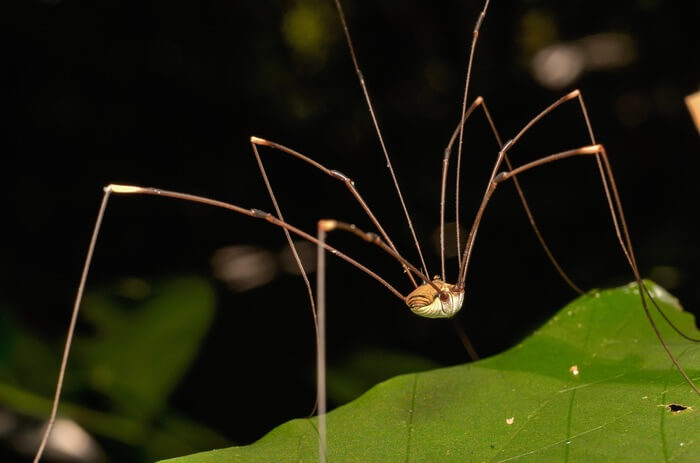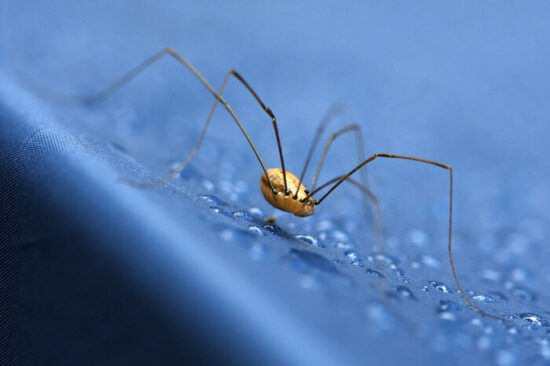Getting rid of daddy long legs in your house (or yard) isn’t something that everyone is comfortable with. There’s so much misinformation regarding these little creatures that most people aren’t sure what to do!
This guide will teach you how to get rid of daddy long legs and prevent them from coming back into your house.
Table of contents
What Are Daddy Long Leg Spiders?
Daddy long legs are a severely misunderstood insect species. Also known as harvestmen, cellar spiders, and a host of other nicknames, these critters are the subject of many myths and rumors.
Let’s start with the classification.
While daddy long legs are arachnids, they’re not true spiders. They lack many of the signature features that creatures in the Araneae order have. This creature doesn’t have fangs or a collection of eight eyes. Instead, they’re sporting tiny claws and a single pair of eyes.

Even the body is different. Daddy long legs have a fused and rounded body, while true spiders have a segmented one. Despite the true classification, most still refer to these arachnids as spiders because of their eight-legged nature (we’ll do the same throughout this post).
As their name would imply, daddy long legs have lengthy appendages. The legs can be up to 50 millimeters long, considerably larger than the mere two to ten-millimeter body width.
The legs aren’t just for show! They help the spider cover a fair amount of ground when they scurry. Plus, it puts them in a prime position for eating prey.
Quick Tip: There are several types of daddy long legs out there, but most are brown, gray, or black. If you look closely, you might spot some vivid patterns on the body.
Are They Dangerous?
You’ve likely heard the rumors about daddy long legs at some point! The myth says that these critters are potent enough to take down a full-growth elephant! However, their mouths are far too small to bite humans.
Is any of that true? While that would certainly make these arachnids a lot more interesting, there’s no truth to those legends at all!
Daddy long legs are nothing more than a harmless annoyance (even when dealing with a large infestation). These spiders don’t even produce silk or weave webs. Nor do they bite or spread disease.
Their presence can be a little unnerving when they’re inside the home, but daddy long legs are one of the good guys!
When outside in your garden, daddy long legs consume other insects. More specifically, they get rid of aphids and other spiders. They also scavenge for eggs, eat plant detritus, and keep your garden in good shape!
It’s when they get into the house that some people start wanting to get rid of them.
Where They’ll Hide In Your House
Typically, daddy long legs are more prevalent around the spring and summer seasons. Females lay eggs in the soil during the fall. After hatching in the Spring, the spiders immediately start looking for a comfortable place to live.
They prefer dark and humid spaces. This means you’re most likely to find them in:
- Basements
- Crawlspaces
- Garages
Any room that doesn’t have adequate ventilation will harbor these spiders.
Quick Tip: You may see them in rooms with leaky faucets and plumbing as well. For example, many homeowners encounter them in the laundry room, bathroom, and kitchen.
What Attracts Daddy Long Legs?
Like any other household pest, daddy long legs move inside in search of food, water, and shelter.
In most cases, they start their lives outside, living in the garden. These spiders gravitate towards debris-filled areas. Piles of rock, wooden logs, and even mulch are all havens for these critters.
Because they like to live in loose debris, daddy long legs tend to stay pretty close to your house’s perimeter. Before you know it, they spot a potential access point and move in.
Quick Tip: Some say that cool-toned light attracts daddy long legs. That might be true to some extent, but these arachnids prefer to live in darker environments. Because they’re so small, all it takes is for them to find a small crack or void and they’re happy.
Once inside, the spider will typically move towards humid spots with access to water nearby. Leaking pipes and faucets are ideal, but they’ll also settle for high humidity levels in the basement or crawl space.
Another potential attractor is food. Daddy long legs feed on a wide range of insects. If you have another pest problem in the home, don’t be surprised to find these critters in the vicinity!
Daddy long legs primarily feed on small bugs like ants or aphids. However, they’ll also consume small silverfish, spiders, centipedes, and even nymph roaches!
How To Get Rid Of Daddy Long Legs
While daddy long legs don’t pose any threat to your family’s health, it’s understandable that you would want to get rid of them. No one likes having arachnids crawling around where they live. Fortunately, doing so is pretty easy with a bit of know-how.
Here are some of the most effective ways to get rid of daddy long legs spiders.
1. Tidy Up
If you want to learn how to get rid of daddy long legs, the most important thing to remember is the impact a clean environment can have. As we mentioned earlier, daddy long legs like to live in loose debris. Outside, they thrive with the natural cover of fallen logs, piles of rocks, and even mounds of compost.
Those natural forms of clutter offer many nooks and crannies for the spider to hide in when trouble arises. They’re the ultimate forms of security.
Inside your house, daddy long legs have to find other forms of shelter. The next best thing beyond yard debris? Room clutter!
Piles of clothes, strewn trash, and other messes are perfect for daddy long legs! An unkempt home provides plenty of opportunities for these spiders to find shelter. As a result, they won’t hesitate to move in.
Do a deep clean of your home. Pick up any clutter you might have in your home and take a vacuum to all floors. It’s a good idea to dust surfaces and clean up all those dark and neglected corners, too.
Doing so will decrease the number of available hiding spots, getting rid of the daddy long legs by forcing them to look elsewhere.
2. Remove Sources Of Food & Water
Another way you can get rid of daddy long legs and prevent an infestation is by removing all food and water sources. These creatures need sustenance to survive! Without it, they’ll have no choice but to move out.
Daddy long legs eat small bugs, so it can be tricky to eliminate all potential food sources. However, it’s still manageable with a bit of vigilance.
Start by sticking to a routine cleaning schedule. Not only does that remove hiding spots, as we mentioned earlier, but it’ll also help eradicate other household pests. Ants, cockroaches, and other potential food sources like clutter just as much as daddy long legs!
They also love those small crumbs of food that tend to accumulate on your countertops, furniture, and floors. Keeping a clean home will attract fewer bugs, severely limiting what daddy long legs have to eat.
To eliminate sources of water, do an inspection of your home. Take a look around the areas where you see these critters. There’s a good chance that you’ll find a leaking pipe or dripping faucet. You may even see pools of stagnant water that collect from condensation.
Address those issues, and you should see the daddy long legs population drop.
Quick Tip: It may also be worth investing in dehumidification techniques. You’ll see the most impact if you’re dealing with daddy long legs in your basement. Improving ventilation and getting rid of some of the water vapor in the air will do a lot to address the bug situation.
3. Use A Natural Spray
If the problem persists, you can use natural repellent sprays to get rid of daddy long legs.
Many chemical-based products are available. However, their efficiency is hit or miss with daddy long legs. Not only that, but they can pose a potential health risk for you and your family. The fumes can get overwhelming, triggering allergies and causing breathing difficulties.
It’s far better to stick with natural alternatives. It’s not hard to find store-bought sprays that utilize all-natural ingredients. However, you can also make your own!
Daddy long legs show an aversion to essential oils like lemon, citronella, peppermint, tea tree, lavender, and eucalyptus. These oils have an intense smell that the insects don’t like. They also have limonene, which is a natural compound with many bug-repelling properties.
Quick Tip: To create a spray, add a few drops of oil to a spray bottle filled with water. The more essential oils you add, the more potent the spray becomes. Plus, the pleasant and fresh smell it leaves behind gets stronger.
Apply the spray all over your home. Pay close attention to those dark and humid spots where daddy long legs hide. You can even go outdoors and apply the spray to your home’s perimeter for good measure.
4. Place Sticky Traps
Sticky traps are surprisingly effective against critters like the daddy long legs spider. They’re easy to use and don’t require the use of chemicals or sprays.
Available at most hardware stores, sticky traps are nothing more than large pieces of paper covered in glue. You can also find them in ribbon form to hang from the ceiling or tube form to prop on a desk.
Set your traps up in the rooms where you encountered the daddy long legs. One great technique is to put them right under the doorframe or adjacent to any other access point. That way, the spider has no choice but to walk on the trap to enter the room.
Once they do, the glue will prevent the spider from escaping. Because they have such a wide leg spread, daddy long legs fall prey to traps pretty quickly. Some may flee by sacrificing a leg, but most will get stuck (allowing you to get rid of them).
How To Keep Them Out Of Your House
Once you’ve gotten rid of daddy long legs, it’s time to prevent them from coming back. Keeping these critters out of your home is an ongoing task. You might see success getting rid of all the existing spiders, but there’s always a chance that they can return.
To prevent that from happening, you need to be proactive about keeping your home clean. Stick to a routine and vacuum all surfaces regularly. You’d be surprised by how much of a difference maintaining a tidy house makes!
Don’t just focus your attention inside. Most daddy long legs migrate into your home after they emerge from the soil in the Spring. You can see great success by making your yard as inhospitable to these pests as possible.
Cut back plants surrounding your home and do your best to prevent yard debris from piling up. Get rid of leaf piles and secure any compost bins or trash cans in the area.
Having daddy long legs in your garden is beneficial, but they should stay as far away from your home as possible. Keep the yard clean around the structure, and they should gravitate towards places where they’ll be beneficial instead of invading your house. They’re one of the many natural predators of ants and other pesky garden insects, so let them help you!
Closing Thoughts
Learning how to get rid of daddy long legs is a relatively simple process. It’s staying consistent and putting that knowledge into practice that many people struggle with!
But as long as you set up a schedule and do the work, you won’t have to worry about an infestation. As a matter of fact, you’ll be able to use these helpful spiders to keep other insect pests away.


